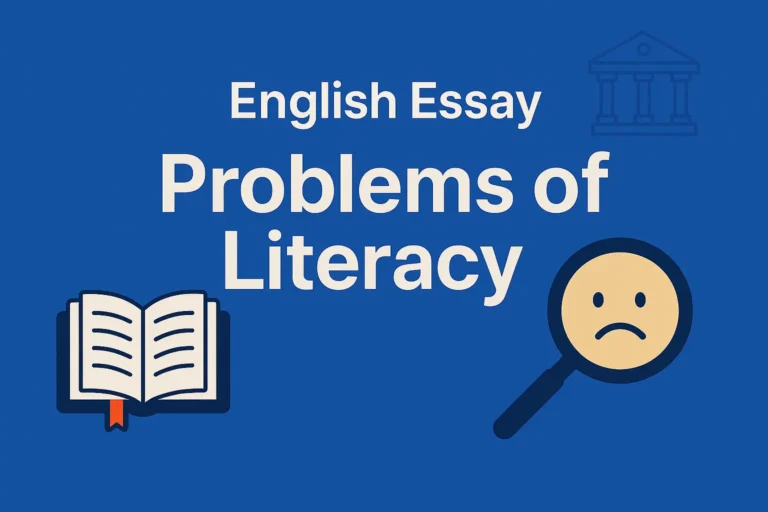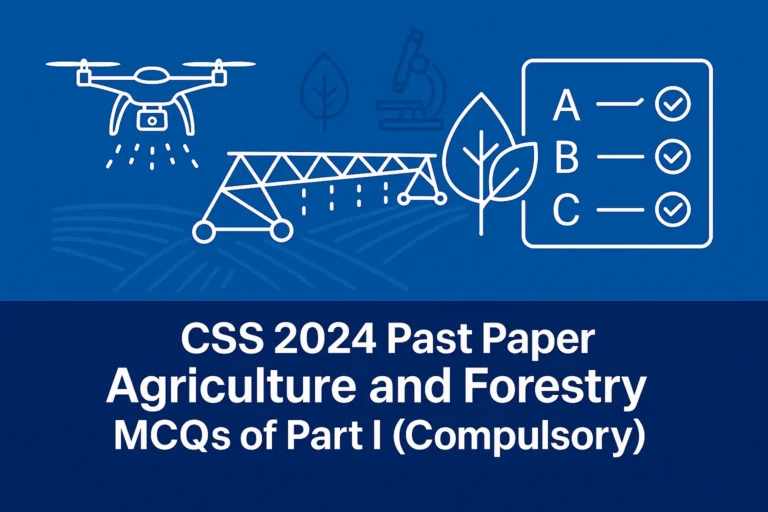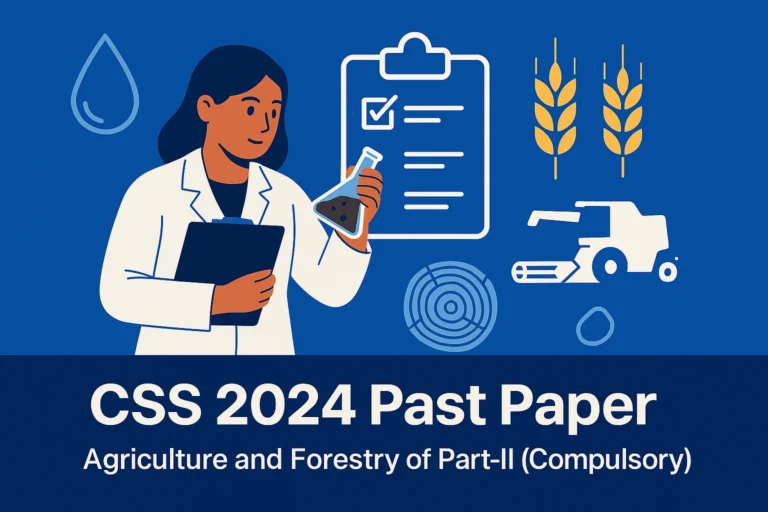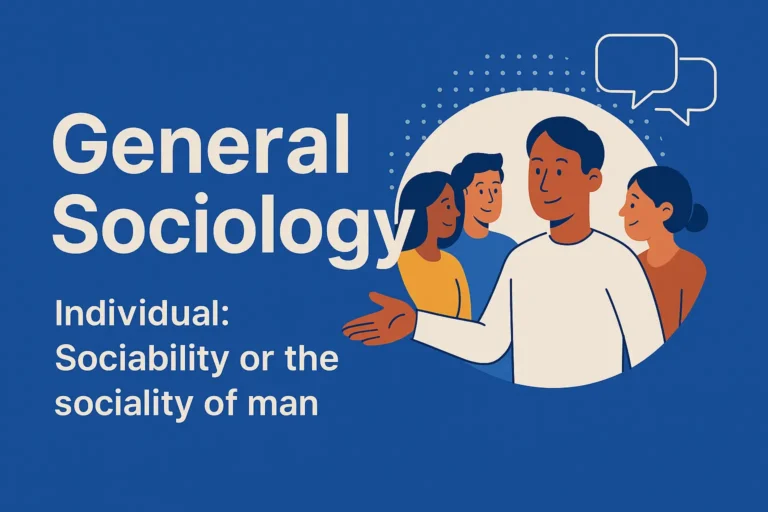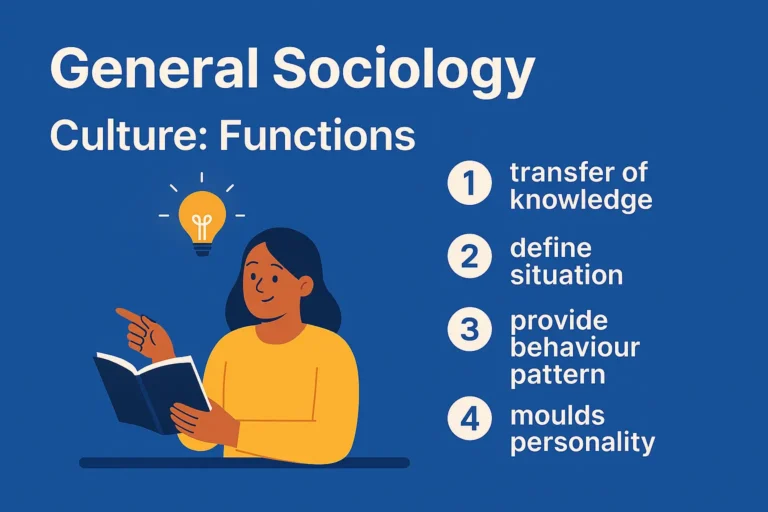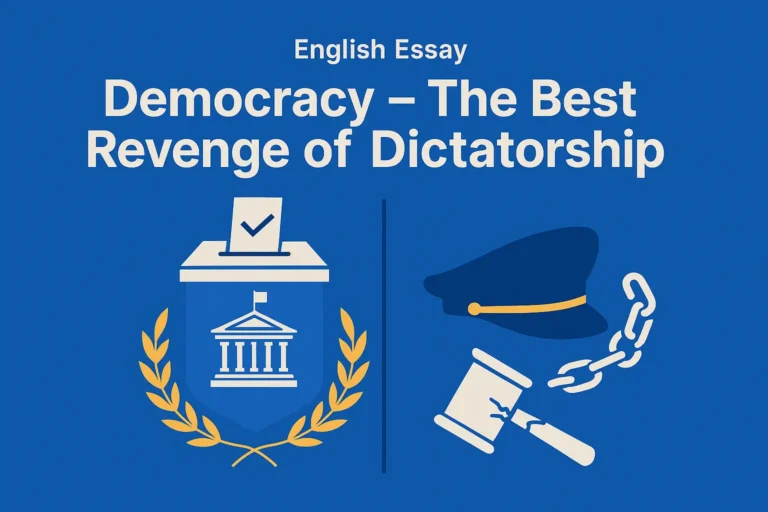CSS 2023 Solved Past Paper – Journalism & Mass Communication Part-II (Compulsory)
Below is the solution to PART-II (COMPULSORY) of the CSS 2023 Journalism & Mass Communication Paper.
Question 2
What is social responsibility theory? Explain its importance with logic and arguments. Also give examples with reference to Pakistani society.
Introduction
Social Responsibility Theory is one of the most important media theories in the field of Journalism and Mass Communication. This theory talks about how media should act responsibly and serve the public by providing correct, fair, and balanced information. It focuses on ethics, truth, and the role of media in society.
What is Social Responsibility Theory?
This theory was developed in the mid-20th century, mainly after World War II. It came as a response to the problems created by the Libertarian Theory, which gave too much freedom to media. People realized that freedom without responsibility can harm society.
So, a group of scholars known as the Hutchins Commission in the USA in 1947 gave the idea of this theory. They said:
“Freedom of the press is essential, but with this freedom comes responsibility”.
So according to Social Responsibility Theory, media should:
- Tell the truth
- Show all sides of a story
- Avoid hate speech and violence
- Be accountable for their work
- Support democracy and public welfare
Importance of Social Responsibility Theory
- Promotes Truth and Transparency
Media has a big influence on people’s minds. If they spread fake news or biased opinions, it can damage the society. This theory promotes truth and transparency. - Protects Public Interest
Instead of running only for profit or ratings, the media should think about the public interest. It should give voice to the poor and highlight real problems of the people. - Builds Trust in Media
When media works honestly and follows ethics, people trust them more. This trust is very important in a democratic society. - Stops Misinformation and Propaganda
Fake news, yellow journalism, and propaganda can create panic and hatred. This theory tries to stop such practices by encouraging ethical journalism. - Strengthens Democracy
Free and fair media is called the fourth pillar of democracy. But freedom must be used with care. That’s why responsibility matters.
Examples from Pakistani Society
- Positive Role
Some Pakistani media channels and journalists highlight social issues like women’s rights, child abuse, climate change, etc. For example, programs like Meray Mutabiq, Capital Talk, or documentaries by Sharmeen Obaid Chinoy show responsibility by focusing on real problems. - Negative Role
Sometimes, media becomes too commercial. They show breaking news just for TRPs, without checking facts. In political talk shows, some anchors spread hate or do biased reporting. - Fake News on Social Media
In Pakistan, social media also plays a big role now. But fake news spreads very fast. For example, during elections or national crises, some pages share false information which creates confusion among people. - Media During National Disasters
During floods or earthquakes, responsible media can guide people, help with donations, and show the problems of victims. This shows how important media’s role is in emergencies.
Challenges in Pakistan for Responsible Media
- Political pressure
- Owners’ business interests
- Lack of proper training for journalists
- Weak regulations and PEMRA not always effective
- Sensationalism for ratings
Conclusion
Social Responsibility Theory reminds us that freedom of media is a good thing, but it should not be misused. Media must work for the betterment of society. In a country like Pakistan, where people rely a lot on news and media, being responsible is not just important — it’s necessary. Media can make or break society, so journalists must use their power wisely and ethically.
Question 3
The excessive use of mobile phone affecting the studies of school/college students. Give your opinion with logic and arguments.
Introduction
Mobile phones have become a major part of our daily life. Especially among school and college students, their use is very common. But nowadays, excessive use of mobile phones is creating serious problems in their academic performance. In my opinion, overuse of mobile phones is badly affecting the studies of students, and this issue must be taken seriously.
How Mobile Phones Affect Studies?
- Wastage of Time
Students spend hours on mobile phones using TikTok, Instagram, YouTube, and other apps. This time was supposed to be used for studying or doing homework. - Distraction in Class
Many students keep checking their phones even during class. They don’t listen properly to teachers and miss important points. - Lack of Concentration
When students use mobile phones too much, their attention span becomes short. They find it hard to focus on books or lectures for long. - Sleep Problems
Using phones late at night affects sleep. Students don’t get enough rest and feel tired in the morning. This affects their learning and health too. - Poor Academic Results
Many students who are addicted to mobile phones often fail to perform well in exams. They prepare at the last minute and can’t compete with serious students. - Mental Health Issues
Social media makes students compare themselves with others. It leads to anxiety, stress, and depression. Instead of focusing on studies, they feel low and demotivated.
Examples and Observations
- In many schools and colleges in Pakistan, teachers complain that students are not interested in books. Their mind is always on mobile notifications.
- During online classes (especially during COVID-19), many students didn’t study seriously and used the phone for gaming or scrolling social media instead.
- A report by Punjab Higher Education Commission showed that mobile addiction is becoming a major reason behind poor grades in colleges.
Counter Argument: Is Mobile Always Bad?
No, mobile phones are not always harmful. If used in a limited and smart way, they can help students. For example:
- Students can watch educational videos on YouTube
- Use dictionary or learning apps
- Attend online lectures
- Connect with teachers or classmates
But the problem starts when mobile usage becomes excessive and replaces real learning.
How to Control the Problem?
- Setting Time Limits
Students should fix time for phone use and avoid using it during study time. - Parental Control
Parents must keep a check on what their children are watching and for how long. - Teachers’ Role
Teachers should guide students on digital discipline and also use digital tools for learning in a controlled way. - Awareness Campaigns
Schools and colleges should hold seminars on mobile addiction and its side effects. - Use Phones for Learning, Not Wasting Time
Students should be taught to use technology for education, not just entertainment.
Conclusion
To sum up, excessive use of mobile phones is truly damaging the studies of school and college students. It kills time, reduces focus, and affects mental health. While mobile phones are not completely bad, students need to learn how to use them responsibly. Parents, teachers, and society must work together to create awareness and save the future of our youth.
Question 4
Explain in detail the code of ethics for media professionals.
Introduction
Media plays a strong role in shaping public opinion. Journalists and media workers hold power to inform the public. But with power comes responsibility. That’s why every media professional must follow a Code of Ethics. These are rules and guidelines which help journalists stay fair, honest, and responsible in their work.
What is Code of Ethics?
Code of ethics is like a moral compass. It tells media professionals what is right and wrong while reporting news or writing stories. These rules are not just written for show, but they are important to build trust between media and public.
Main Points of Media Code of Ethics
- Truth and Accuracy
Journalists must always tell the truth. News should be based on facts. Spreading false or half-true news is against ethics. - Objectivity and Fairness
News should not be biased. Media must show all sides of a story and let people decide. Personal opinions of the reporter should not mix with the news. - No Hate Speech
Media should not spread hate based on religion, race, caste, gender, or nationality. It must promote peace, not violence. - Respect for Privacy
Every person has a right to privacy. Media should not invade someone’s personal life unless it’s a matter of public interest. - Avoid Sensationalism
Sensational headlines and dramatic news just to grab attention are unethical. Truth should not be twisted for more ratings. - Correction of Mistakes
If media makes a mistake, they must correct it quickly and clearly. Hiding errors damages credibility. - Independence from Influence
Journalists should not be under pressure from political parties, advertisers, or big businessmen. Independent reporting is key for real journalism. - Respect for Law and Culture
Media should follow the law of the country and respect its culture and traditions. Vulgarity or offensive content must be avoided. - Protection of Sources
If a journalist takes information from a secret source, they must protect the identity of that person. - No Plagiarism
Using someone else’s work or ideas without giving credit is unethical. Journalists must write original content.
Importance of Code of Ethics
- Builds Public Trust
When media follows ethics, people trust the news. Trust is the foundation of journalism. - Protects Democracy
Fair and responsible media supports democracy by informing the people and keeping a check on power. - Reduces Fake News
Ethical journalism stops the spread of rumors, fake news, and propaganda. - Saves Media’s Reputation
When journalists follow ethics, media gains respect locally and internationally.
Examples from Pakistani Media
- Some news channels in Pakistan sometimes break the ethics by showing graphic violence or biased political reporting.
- In 2020, a few channels spread false news about a celebrity’s death. Later it was proven fake. This was a violation of truth and accuracy.
- On the other hand, independent platforms like Dawn News or Geo’s special reports often follow ethical standards in investigative journalism.
PEMRA and Ethical Guidelines in Pakistan
PEMRA (Pakistan Electronic Media Regulatory Authority) has its own rules and code of conduct for TV and radio channels. It tries to ensure:
- No hate content
- No disrespect to national institutions
- Content suitable for all age groups
- Decency and respect for religion
But still, many channels don’t fully follow these rules and need better regulation.
Conclusion
Code of ethics is the backbone of honest journalism. Without ethics, media becomes a tool of propaganda, lies, and drama. In Pakistan, where media has a big influence on society and politics, following ethics is more important than ever. Journalists must remember they are not just working for ratings, they are serving the nation.
Question 5
Elaborate in detail the diffusion and innovation theory, its merits and demerits and its applicability in Pakistani society.
Introduction
In today’s fast-moving world, new ideas, technologies, and trends spread quickly from one person to another. This process is explained by Diffusion of Innovation Theory, which tells how new things get accepted by people in a society. The theory was introduced by Everett Rogers in 1962 and it became a famous concept in communication and development studies.
What is Diffusion of Innovation Theory?
This theory explains how a new idea, product, or technology spreads (diffuses) through a population over time. The process involves innovation (the new idea) and communication (how it’s shared).
According to the theory, people adopt new things in different stages. Rogers divided them into five categories:
- Innovators – Risk-takers who adopt new things first
- Early Adopters – Opinion leaders who follow innovators
- Early Majority – People who adopt after seeing its benefits
- Late Majority – Skeptical people who adopt after most others
- Laggards – Last ones to adopt, usually traditional and resistant
Elements of the Theory
- Innovation – The new idea or technology
- Communication Channels – How information about innovation spreads
- Time – The time it takes to adopt innovation
- Social System – The community where the innovation spreads
Example
Let’s take mobile banking in Pakistan. First, innovators and tech-savvy people used apps like JazzCash or Easypaisa. Later, early adopters promoted it. Now, many people even in villages are using these apps. Laggards are still using cash and avoid digital tools.
Merits of Diffusion of Innovation Theory
- Explains Adoption Process
It clearly shows how people accept new ideas in steps. - Helps in Planning Campaigns
Companies, governments, and NGOs use it to plan how to introduce something new. - Useful in Development Communication
Helps in promoting education, health awareness, and agriculture techniques. - Encourages Innovation
It supports innovation by understanding how to spread it in society.
Demerits of the Theory
- Ignores Cultural Barriers
Sometimes it doesn’t consider traditions or religious factors that stop innovation. - Focus on Individuals Only
It looks at personal decisions more than government or group influence. - Not Always Linear
The adoption process is not always step-by-step. Sometimes people skip stages. - Tech-Centered
Originally, it focused more on technology, not social changes.
Applicability in Pakistani Society
- Mobile Technology
Apps like JazzCash, Careem, and Foodpanda spread using this model. Urban people adopted them early. Rural areas took more time. - Health Campaigns
Polio vaccine awareness used this theory. Early adopters helped convince others. But due to cultural resistance in some areas, laggards still exist. - Agricultural Tools
New seeds, fertilizers, and farming machines were adopted slowly by Pakistani farmers. Early adopters helped spread the word. - Education Technology
Online learning apps became famous during COVID-19. Some schools adopted quickly, while others still struggle with it. - Women Empowerment
New ideas about women’s education and work are spreading, but still face resistance in traditional areas.
Challenges in Pakistan
- Low literacy rate
- Internet issues in remote areas
- Resistance from religious/traditional groups
- Lack of awareness campaigns
- Poverty and access issues
Conclusion
Diffusion of Innovation Theory is very useful to understand how new ideas and technologies spread in any society. In Pakistan, it has been seen in health, education, agriculture, and mobile tech. But to make it more effective, we need strong communication, cultural understanding, and support from leaders. Only then innovations can truly benefit the whole population.
Question 6
What is development support communication? How it can be helpful for national development? Support your answer with logic & arguments.
Introduction
Development Support Communication (DSC) is a special kind of communication that is used to support development goals. It helps spread awareness, educate people, and bring positive changes in society. In simple words, DSC uses media and communication tools to support areas like education, health, agriculture, environment, and women empowerment.
Definition of Development Support Communication
According to UNESCO:
“Development support communication is the planned use of communication to support development programs.”
It focuses on “people-centered” development. That means it tries to involve local communities and give them useful information so they can improve their own lives.
Key Features of DSC
- People-focused – Main goal is to help the common people.
- Two-way Communication – Not just telling, but also listening.
- Uses Multiple Channels – TV, radio, posters, theatre, mobile apps, etc.
- Supports Government & NGO Projects – Like education, health, agriculture.
- Behavior Change – Helps change attitudes and habits.
Tools of Development Support Communication
- Radio programs in rural areas
- TV public service messages
- Posters and billboards
- SMS/mobile alerts
- Social media campaigns
- Street theatre and awareness camps
How DSC Helps in National Development?
- Education Promotion
DSC promotes literacy by running campaigns about school enrollment, adult education, and girls’ education.
Example: “Taleem Sab Ke Liye” ads by Govt of Punjab. - Health Awareness
Through media messages, people learn about vaccination, hygiene, nutrition, and diseases like polio or dengue.
Example: COVID-19 awareness campaigns in Pakistan. - Agriculture Improvement
DSC helps farmers learn new techniques, weather forecasts, fertilizer use, and modern farming.
Example: Radio Pakistan’s “Kisan Time” for rural farmers. - Women Empowerment
It educates women about their rights, health, and opportunities.
Example: Aurat Foundation’s media campaigns. - Environmental Protection
Through communication, people learn how to protect forests, save water, and manage waste. - Disaster Management
DSC warns people during floods, earthquakes, or heatwaves. It also teaches them how to stay safe.
Example: NDMA awareness messages. - Poverty Reduction
By informing people about govt schemes like Ehsaas Program, BISP, and microfinance loans, it helps reduce poverty.
Role of Media in DSC
Media is the backbone of development communication. It helps reach both rural and urban areas quickly. Pakistani media like PTV, Radio Pakistan, and many NGOs play this role. Even social media now helps in spreading development messages.
Challenges in Pakistan
- Low literacy rate
- Poor media access in remote areas
- Cultural and religious barriers
- Lack of coordination between govt and media
- Budget issues in development campaigns
Solutions
- Train more development communicators
- Use local languages for messages
- Use mobile phones and radio in rural areas
- Involve community leaders and influencers
- Collaborate with NGOs and educational institutions
Conclusion
Development Support Communication is not just about sharing information — it’s about changing lives. In a country like Pakistan, where there are many social and economic issues, DSC can play a big role in national development. With the right planning, good media use, and support from all sectors, we can use communication as a tool to build a better, educated, and healthier Pakistan.
Question 7
Suppose you are a PRO of Police department. Suggest a plan and measure to control street crime in the country.
Introduction
Street crime is one of the major problems in many cities of Pakistan, especially in Karachi, Lahore, and Rawalpindi. These crimes include mobile snatching, purse stealing, bike theft, pickpocketing, and sometimes armed robbery. As a Public Relations Officer (PRO) of the Police Department, it is my duty to not only communicate with the public but also help improve the image and performance of the police through planning and awareness.
Current Situation of Street Crime in Pakistan
- Increasing day by day, especially in urban areas
- Most common crimes: mobile snatching, motorcycles theft, purse snatching
- Citizens feel unsafe, especially at night
- Lack of trust between public and police
- Poor reporting of crimes due to fear or disappointment
Proposed Plan to Control Street Crime
As PRO, I would suggest the following multi-step plan:
1. Strong Media & Awareness Campaign
- Launch public awareness through TV, radio, newspapers, and social media.
- Educate citizens on how to stay alert and report crime.
- Campaign slogans like “Safe City, Safe Citizens” or “Say No to Street Crime”.
2. Community Policing Program
- Involve local people in fighting crime.
- Arrange monthly meetings between police and community leaders.
- Create volunteer “neighborhood watch” groups.
- Build trust between police and citizens.
3. Use of Technology
- Install CCTV cameras in crime hotspots.
- Launch a mobile app for quick crime reporting with location.
- Use GPS tracking in stolen phones and bikes.
- Develop E-Police Reporting System for fast and paperless FIR.
4. Police Patrolling Boost
- Increase number of patrol cars and bikes, especially in high-crime areas.
- Set up checkposts at major entry/exit points of cities.
- Ensure patrolling during peak crime hours like evening and late night.
5. Crackdown on Gangs and Drug Addicts
- Special police teams to identify and arrest repeat criminals and gang members.
- Work with anti-narcotics force to tackle drug users who often commit street crimes.
6. Improve Police Image and Behavior
- Train police officers in public dealing and soft communication.
- Take strict action against corrupt officers.
- Promote “police help culture” instead of fear.
7. Youth Engagement Programs
- Involve students in anti-crime awareness.
- Launch “Police-Student Partnership” for positive image.
- Arrange seminars in schools and colleges about safety.
8. Quick Justice System
- Work with judiciary for fast trial of street criminals.
- Set up Special Courts for street crime cases.
Expected Results
- Decrease in street crime rate
- Improved police-public relationship
- Citizens feel safer and more cooperative
- Better image of police in media and society
- More use of digital tools for crime control
Challenges
- Lack of funding for technology
- Resistance from public due to fear of police
- Political interference in police work
- Delayed court processes
- Weak coordination between departments
Conclusion
Street crime is not just a police issue; it is a social issue that needs teamwork. As a PRO, I believe that strong communication, public awareness, and smart policing can bring big change. If police, media, and community work together, we can make our cities safer and bring peace to our streets.
Question 8
Write notes on any TWO of the following:
a. Press-Government relatives in Pakistan
b. PEMRA
c. Role of media in Democracy
a. Press-Government Relatives in Pakistan
Introduction
The relationship between the press and the government in Pakistan has always been a mix of cooperation, control, and conflict. Since independence in 1947, Pakistan has seen both democratic and military governments, and media has faced pressure from both sides.
Key Aspects of Press-Government Relations
- Censorship and Control:
During military regimes (like under Ayub, Zia, and Musharraf), press was heavily censored. Newspapers were banned, journalists were arrested, and freedom of expression was limited. - Democratic Era Challenges:
Even in democratic governments, media faced restrictions. Sometimes, government used advertising money as a tool to control media content. - PEMRA and Media Laws:
Government uses regulatory bodies like PEMRA to monitor electronic media, which often leads to complaints of unfair bans or pressure on channels. - Freedom vs. Responsibility:
Government often says media spreads fake news, while press claims government attacks freedom of speech. The balance is still missing. - Recent Examples:
- Bans on certain talk shows or journalists.
- Attacks on media offices and reporters.
- Social media censorship in the name of “national security”.
Conclusion
Press-government relations in Pakistan are not ideal. There must be freedom with responsibility and regulation without control. Only then we can build a healthy democratic society with a free press.
b. Pakistan Electronic Media Regulatory Authority (PEMRA)
Introduction
PEMRA (Pakistan Electronic Media Regulatory Authority) is a regulatory body in Pakistan that controls and manages the licensing, content, and rules for TV channels, FM radio, and now digital media. It was established under the PEMRA Ordinance 2002.
Functions of PEMRA
- Licensing:
Issues licenses to private TV channels, FM radios, and cable operators. - Monitoring Content:
Makes sure channels don’t show content that is against religion, culture, national interest, or moral values. - Code of Conduct:
Enforces ethical guidelines for broadcasters. This includes hate speech, vulgarity, and fake news prevention. - Taking Action:
Can fine, suspend, or ban a channel or program that breaks the rules. - Promoting Media Growth:
Encourages healthy competition and media expansion across the country.
Criticism of PEMRA
- Accused of being used as a political tool.
- Banning channels without fair process.
- Unclear guidelines on what content is “anti-state”.
- Lack of independence — under control of Ministry of Information.
Conclusion
PEMRA (Pakistan Electronic Media Regulatory Authority) can play a positive role in improving media quality, but it must be free from political influence. It should focus on guidance, not punishment.
c. Role of Media in Democracy
Introduction
Media is often called the “Fourth Pillar of Democracy” after Legislature, Executive, and Judiciary. It informs the public, holds power accountable, and gives people a platform to express opinions.
Key Roles of Media in Democracy
- Information Provider:
Keeps citizens updated about national and global issues, policies, and political developments. - Watchdog Role:
Exposes corruption, bad governance, and injustice through investigative journalism. - Voice of the People:
Gives space to public opinion, minority voices, and civil society. - Promotes Transparency:
Keeps check on power and makes government actions visible to the public. - Educates Voters:
Helps people understand political processes, parties, and elections. - Strengthens National Debate:
Talk shows, debates, and opinion columns help in shaping democratic views.
Problems in Pakistani Context
- Bias in media
- Paid content
- Political ownership of media houses
- Fake news and propaganda
Conclusion
For a strong democracy, media must be free, fair, and responsible. It should not act as a political player, but as a bridge between people and power.

